Human Orbital Spaceflights
![]()
International Flight No. 76Soyuz 39PamirUSSR |
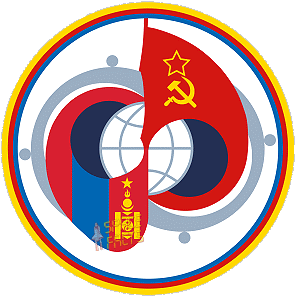 |
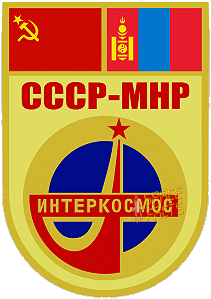 |
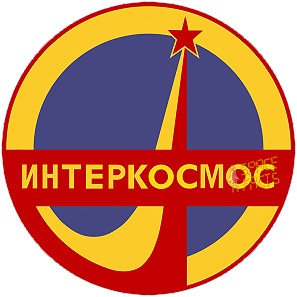 |
||
![]()
Launch, orbit and landing data
walkout photo |
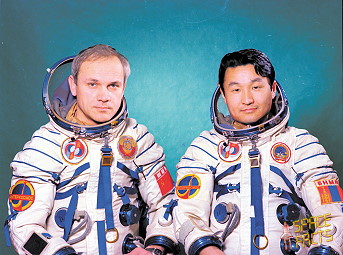 |
|||||||||||||||||||||||
alternative crew photo |
alternative crew photo |
|||||||||||||||||||||||
alternative crew photo |
alternative crew photo |
|||||||||||||||||||||||
alternative crew photo |
alternative crew photo |
|||||||||||||||||||||||
Crew
| No. | Surname | Given names | Position | Flight No. | Duration | Orbits | |
| 1 | Dzhanibekov | Vladimir Aleksandrovich | Commander | 2 | 7d 20h 42m 03s | 124 | |
| 2 | Gurragcha | Zhugderdemidiyn "Gurr" | Research Cosmonaut | 1 | 7d 20h 42m 03s | 124 |
Crew seating arrangement
|
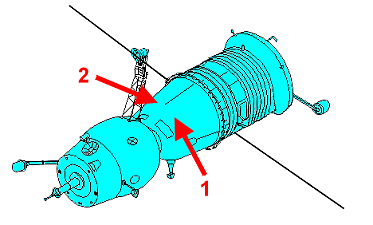 |
|
||||||||||||
Backup Crew
|
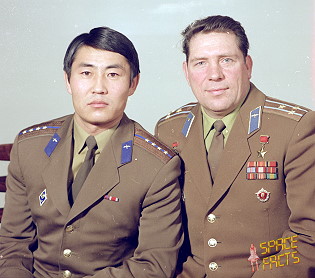 |
|||||||||||||||
alternative crew photo |
Hardware
| Launch vehicle: | Soyuz-U (No. P15000-257) |
| Spacecraft: | Soyuz 39 (7K-T No. 55) |
Flight
|
Launch from the Baikonur Cosmodrome and
landing 170 km southeast of Dzheskasgan. The Mongolian contribution for this mission had begun in 1967, when the president of the Mongolian Academy of Sciences Bazaryn Shirendev attended a conference of scientists from socialist countries in Moscow, where the Intercosmos project was announced. Soyuz 39 marked the eighth Intercosmos mission (with Zhugderdemidiyn Gurragcha, the first cosmonaut from Mongolia). Following a one-day solo flight Soyuz 39 docked with the Salyut 6 space station on March 23, 1981. During the next days the crew performed common scientific work with the fifth resident crew. The cosmonauts installed cosmic ray detectors in the work and transfer compartments. They also performed the Illyuminator ("viewing port") experiment, which studied the degradation of the station's viewports. Vladimir Kovalyonok and Viktor Savinykh also used the Gologramma ("hologram") apparatus to image a viewing port damaged by micrometeoroids. They also collected samples of the station's air and microflora and removed the cosmic ray detectors for return to Earth. Experiments of Earth science were also performed, especially studies of Mongolia from space. The results of the Biosphere-Mon experiment would also prove of great benefit for Mongolia's national economy. Its purpose was to study various objects on the Earth's surface by means of special instruments installed on board Salyut 6. The crew carried out 14 observation assignments over the territory of Mongolia in the interests of geology, agriculture, glaciology, landscape science and meteorology. The Atmosphere, Horizon and Terminator experiments provided information about the transfer functions and other optical characteristics of the Earth's atmosphere. They were carried out by means of the Spectrum-15 instrument developed by Bulgarian specialists. The same instrument was used in the Illuminator and Solongo experiments, the former dealing with the study and qualitative assessment of changes in the spectral transparency of the Salyut station's viewports during its long orbital flight, and the latter aimed at obtaining spectral data on various terrestrial formations. The international crew also carried out a number of experiments in the field of space materials technology. The Altay-1 experiment afforded a deeper insight into the process of mutual diffusion in pure metals - lead and tin - in microgravity conditions. Using the Splav unit, the crew grew crystals of vanadium pentoxide (the Altay-2 experiment). These crystals are active semiconductors used not only in electronics, but also as efficient catalysts in obtaining many organic compounds. The Soyuz 39 cosmonauts carried out the Hologram experiment, which involved the development of new video recording and transmissions techniques, studying the possibility of sending holograms to and from Earth. The equipment they used for this purpose had been developed by Soviet and Cuban scientists. Using equipment developed by Soviet and Mongolian scientists, the crew conducted experimental research into primary cosmic radiation the first experiment of this kind to be performed aboard the orbiting complex. Space particles were recorded by dielectric detectors mounted in the command module and lock chamber. These recordings would enable specialists to determine the charges and energy levels of space atomic nuclei. The Soyuz spacecraft is composed of three elements attached end-to-end - the Orbital Module, the Descent Module and the Instrumentation/Propulsion Module. The crew occupied the central element, the Descent Module. The other two modules are jettisoned prior to re-entry. They burn up in the atmosphere, so only the Descent Module returned to Earth. The deorbit burn lasted 188 seconds. Having shed two-thirds of its mass, the Soyuz reached Entry Interface - a point 400,000 feet (121.9 kilometers) above the Earth, where friction due to the thickening atmosphere began to heat its outer surfaces. With only 23 minutes left before it lands on the grassy plains of central Asia, attention in the module turned to slowing its rate of descent. Eight minutes later, the spacecraft was streaking through the sky at a rate of 755 feet (230 meters) per second. Before it touched down, its speed slowed to only 5 feet (1.5 meter) per second, and it lands at an even lower speed than that. Several onboard features ensure that the vehicle and crew land safely and in relative comfort. Four parachutes, deployed 15 minutes before landing, dramatically slowed the vehicle's rate of descent. Two pilot parachutes were the first to be released, and a drogue chute attached to the second one followed immediately after. The drogue, measuring 24 square meters (258 square feet) in area, slowed the rate of descent from 755 feet (230 meters) per second to 262 feet (80 meters) per second. The main parachute was the last to emerge. It is the largest chute, with a surface area of 10,764 square feet (1,000 square meters). Its harnesses shifted the vehicle's attitude to a 30-degree angle relative to the ground, dissipating heat, and then shifted it again to a straight vertical descent prior to landing. The main chute slowed the Soyuz to a descent rate of only 24 feet (7.3 meters) per second, which is still too fast for a comfortable landing. One second before touchdown, two sets of three small engines on the bottom of the vehicle fired, slowing the vehicle to soften the landing. |
Photos / Graphics
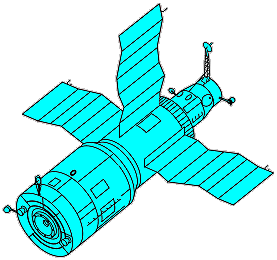 |
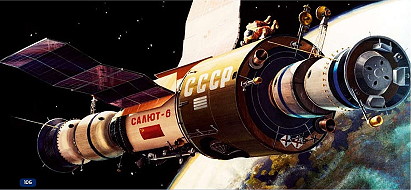 |
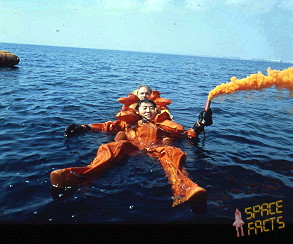 |
 |
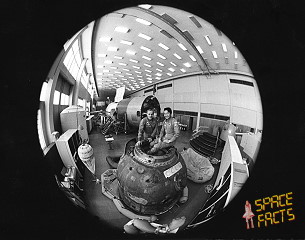 |
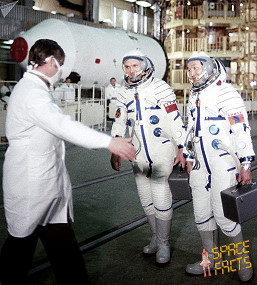 |
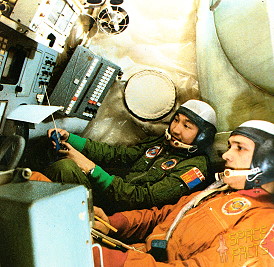 |
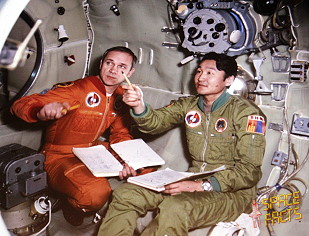 |
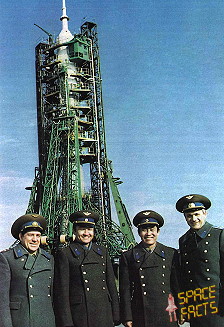 |
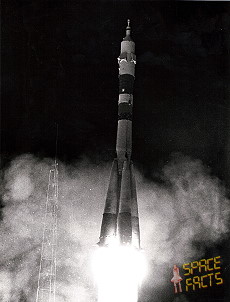 |
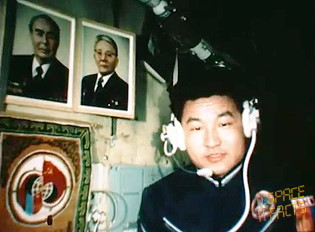 |
 |
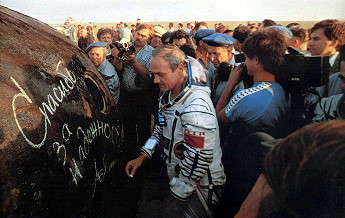 |
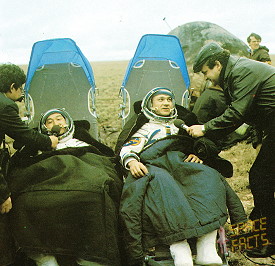 |
| © |  |
Last update on May 14, 2021.  |
 |